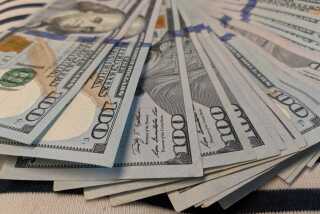Value of Euro Surpasses Dollar
- Share via
PARIS — The euro passed parity with the U.S. dollar Monday, attaining a symbolic breakthrough almost seven months after the 3-year-old European currency went into public use in 12 countries.
The euro was pegged at $1.17 when it was introduced for limited use in January 1999, then plummeted over some 20 months to a low of about 82.3 cents.
Monday’s close in New York at nearly $1.01 meant the euro surpassed the dollar for the first time since February 2000, its rebound propelled by weakening market confidence in the U.S. currency.
The rising euro means tougher times for American tourists in Europe but better times for U.S. exporters, whose goods will be cheaper. Although a robust euro will help keep inflation down in Europe, the news does not mean that the continent’s economy is booming compared with that of the U.S., which still has a better growth rate.
Monday’s milestone is more psychological and political than anything else, analysts said.
“The euro is no longer undervalued, but I don’t think this is a sign of a very strong euro,” said Marc Touati, a financial analyst for Natexis Banques Populaires in Paris. “It is still a long way from overcoming the dollar, which is still the superstar currency. Fifty percent of the world’s transactions are still in dollars, and 70% of the world’s central bank reserves are in dollars. The rise of the euro today is linked to extra-economic factors.”
The euro has benefited from U.S. government policy designed to permit a weak dollar and boost U.S. exports and industry, according to Touati. U.S. officials have insisted there is no policy to weaken the dollar in relation to the euro.
A more worrisome trend also played a role in the weakening of the dollar. Already ailing stock markets are bracing for corporate earning reports expected to reflect the damage of a wave of accounting scandals in the United States, observers said.
European business and financial interests are nonetheless enthused about a success story in the European Union’s sometimes arduous advance toward economic and political integration. Among the institutions welcoming the currency’s two-month surge to parity is the European Central Bank.
“From a point of view of morale, parity is surely a good thing for the European Central Bank, favorable for its self-confidence,” said Julian Landsberger of HyopVereinsbank in Germany. “But from a macroeconomic point of view, I don’t think parity changes a great deal in the current scene.”
The EU’s central bank endured criticism last year during a period when the euro foundered, hitting its nadir of 82.3 cents last summer.
“This confirms that the market is very pessimistic regarding the dollar,” said Nick Parsons of Commerzbank, quoted by the Agence France-Presse news agency. “We could see the dollar drop another 10% this year.
“The principal factor in the decline of the dollar is the poor performance of the American stock market. But there is a risk that this weakening will have repercussions in the world markets.”
Parity, let alone a further slump of the dollar, probably will discourage the U.S. tourists now flooding Paris, London and other capitals as Europe becomes increasingly high-priced. Conversely, the new currency dynamic should attract foreign investors to the euro zone.
But European exporters could suffer if the euro goes too high, according to Touati. Germany would face particular risks because more than 17% of its exports are outside the euro zone, he said.
“The markets will have fun testing how far this can go,” Touati said.
The most probable scenario is that the euro will not go much beyond $1.05, with markets striking a balance between a more attractive investment climate in Europe without ceding too much ground to U.S. trade competitors, some say.
More fundamentally, Europe still trails the United States in terms of growth. The EU economy probably will grow by a maximum 1.3% this year compared with an anticipated 2.5% or better for the U.S. economy, according to Touati.
The euro was officially launched on financial markets in January 1999 by Austria, Belgium, Finland, France, Germany, Ireland, Italy, Luxembourg, the Netherlands, Portugal and Spain. Greece joined the club two years later.
Euros appeared in banks, cash registers and wallets across the zone during a remarkably smooth period of introduction in January. At that point, the euro was worth 90 cents. It began a rebound that has not flagged since.
Although Britain is in many aspects a leading member of the European Union, the British public has steadfastly resisted the notion of adopting the euro and abandoning the sturdy pound, which has a current value of about $1.57. Lately, the administration of Prime Minister Tony Blair has toyed with the idea of putting the issue to the voters in a referendum.
The bottom line, according to analysts, is that the euro has completed what some called its “pilgrimage through the desert.” But times are volatile.
“The rise of the euro is above all speculative and therefore fragile,” Touati said. “It could surpass parity in the short term, but that will not necessarily be durable.”
The weakening of the dollar is also reflected in other currencies. In late New York trading Monday, the dollar fell to 116.31 yen from 116.79 late Friday, while the pound went to $1.57 from $1.55.
More to Read
Sign up for Essential California
The most important California stories and recommendations in your inbox every morning.
You may occasionally receive promotional content from the Los Angeles Times.













